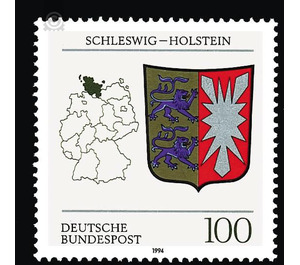Coat of arms of the Land of the Federal Republic of Germany (3) - Germany / Federal Republic of Germany 1994 - 100 Pfennig
Theme: Art & Culture
| Country | Germany / Federal Republic of Germany |
| Issue Date | 1994 |
| Face Value | 100.00 |
| Color | multi-colored white |
| Perforation | K 13 3/4 |
| Printing Type | Multicolor offset printing |
| Stamp Type | Postage stamp |
| Item Type | Stamp |
| Chronological Issue Number | 1588 |
| Chronological Chapter | GER-BRD |
| SID | 965591 |
| In 40 Wishlists | |
The coat of arms of the country Schleswig-Holstein shows in the split shield on the right in gold two blue, red reinforced, crossed, sweeping inward swept for Schleswig, left in red the silver holstein Nesselblatt. Both coats of arms have been to occupy since the 13th century and originally belonged to the governing rulers in the country, namely the Dukes of Schleswig, who came from a branch line of the Danish royal family, and the Count of Holstein from the house Schauenburg. For Schleswig can be shown that the ducal coat of arms was already considered around 1330 as a national coat of arms. The same applies to Holstein at the latest since the second half of the 15th century, when the Nesselblatt found after the extinction of the Schauenburg (1459) inclusion in the coat of arms of the Danish king as the new ruler of Holstein. The coat of arms of Schleswig is to be understood as a derivative of the Danish royal coat of arms. It represents a so-called "coat of arms reduction" with its two lions compared to the three Danish lions, as was customary for secondary lines of a dynasty. Also in the Danish coat of arms of the lion placed crowns and accompanying small hearts are missing in Schleswiger coat of arms, while in the colors match both coats of arms. Whether the Holstein landmark was designed from the outset as a stylized nettle leaf (after a Castle in Burg Netelenburg) or later reinterpreted as such is not entirely clear. In any case, the latter view prevails. It states that the Holstein coat of arms figure was created from a red-ragged stripe, which was placed on a white shield as a border reinforcement, so that the red spikes were originally intended as a shield figure. But already around 1300 the white midfield with its strange shapes became the actual crest content, which was then interpreted as a nettle leaf. A connection of Schleswiger and the Holstein coat of arms in a shield took place for the first time after 1385, when the Schauenburg finally united Schleswig and Holstein under their rule. However, this coats of arms disappeared again with the establishment of the personal union between Denmark and Schleswig-Holstein in the year 1460. The Schleswig and Holstein coat of arms formed from then on for several centuries each for itself a component of the large Danish state coat of arms. Only the collection of 1848 brought for three years again an independent, composed of the two individual coats of arms coat of arms, the division of which corresponds exactly to the present and which was adopted almost unchanged in 1891 by the then Provincial Self-Government. With the change of the Nesselblatt 1928 and the simultaneous turning of the lions inwards, the history of the form of the Schleswig-Holstein coat of arms came to a close for the time being. The government of Schleswig-Holstein, newly formed after 1945, took over the coat of arms of provincial self-government, but redrafted it. The Schleswig lions come first, because Schleswig is the older duchy, while Holstein was raised to 1474 duchy. The inward (ie to the left) position of the lions - they look to the right, if the Schleswig coat of arms appears alone - is based on the principle of the "Sichansehens" of the figures and is an expression of heraldic politeness: The lions are not the Holstein Nesselblatt den Turn back. (Text: Ministry of Economics, Technology and Transport of Schleswig-Holstein)


